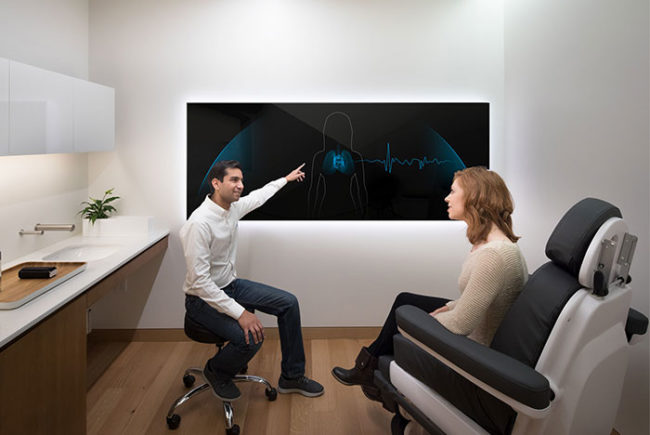
Coordination of telemedicine and other virtual and physical capabilities using AI will be a top priority
Image by Shutterstock
Technology advancements have been at the forefront of improvements in medical diagnosis and treatment procedures for many decades, but artificial intelligence (AI) is driving reconfiguration of nearly all aspects of health care services and delivery, including facilities.
Futuristic devices and pharmaceuticals that have only existed in the imagination of scientists are quickly becoming the standard of care. Robotics and virtual patient encounters grounded in AI are no longer the province of science fiction.
So, what are the implications for the planning and design community and where are the opportunities to participate in this transformation of health care?
Great promise
AI seems to hold great promise for improvements in every aspect of health care: clinical quality, throughput, efficiency, cost control, management, research, community health and design.
As the research and development of AI accelerates, and its use becomes widespread in the management of health as well as the prevention, diagnosis and treatment of disease, it is important to acknowledge that its success cannot exist in a siloed operation or application. Consequently, linkages and networks now characterize every aspect of health care, offering opportunities for data aggregation and analysis in ways and on a scale never before imagined.
As the “internet of things” permeates society and devices with AI capabilities become increasingly intelligent, the volume of information that is available and being managed will require even more reliance on AI-equipped tools by design professionals, among others.
Resources
AI is perhaps the single greatest influence on how the architectural design profession must adapt to the new world of health care that is becoming increasingly data dense simply because of the billions of data-gathering devices (especially mobile phones) and the trillions of data points collected daily.
As more health data becomes available and health care becomes more dependent on AI for its management and analysis, disruptions to the familiar health care field will increase. The design community must be diligent in tracking these innovations for their impact on design, because one of the greatest risks of AI in health care is the potential for accelerated obsolescence of the built environment.
Architects and planners
For decades, changes in health care services and delivery were propelled by regulations, reimbursement or technology — sometimes a combination of two or all three occurring simultaneously. With AI growth expanding throughout the world at an exponential pace, the technological advancements fostered by AI may position technology as the leading driver well into the future.
If the design community can find success using and incorporating AI into the health care architecture model, what does that success look like?
Should health facility architects consider new metrics for success like degree of flexibility to accommodate new AI-influenced technologies; suitability for a facility to undergo asset life extension after first-use obsolescence; facility expandability in the likelihood of linkage to additional facilities and additional technologies; and even disposability in the case of disruptive technologies with predictable short useful lives or which render facilities unnecessary?
Should the health care design community look for success in metrics reflecting greater impact on a community by empowering health systems to serve more people by helping build systems that were not facility dependent; improve any of a variety of population health indicators through more efficient system development; or improve the financial viability of health care providers through the creative design of AI-fueled facilities that are more efficient?
These are not unfamiliar priorities to health care designers, but their importance in an AI-fueled, rapidly transforming field is perhaps greater than ever before.
While traditional health care delivery models have spawned a wide variety of building types, newer delivery models have driven the need for facilities that barely resemble those of past years. In fact, health care architects are now being presented with opportunities that may not be facility centric at all.
Traditional methods of health care delivery and the traditional environments of care created by architects will likely be modified and potentially abandoned as technology increasingly moves patients away from traditional facilities. More care will be delivered outside of hospital environments and in home environments, technologies will foster improved patient experiences, and early detection and prevention techniques will utilize an increasing number of personal, wearable or insertable monitoring devices.
Specifically, architects as planners and designers likely will find opportunities in each of the following four trends as the influence of AI permeates health and health care systems.
1. The health care platform. Greater emphasis on the development of the health care platform, otherwise known as building health care systems, but not using only buildings:
- AI will enable design and modeling of system performance in many new ways. Architects who master this understanding will have an opportunity to favorably impact costs of development or redeployment of facilities.
- AI may herald the end of the concept of the independents (e.g., facilities, providers, practitioners, networks, etc.) because everything about the platform — and the power of AI — lies in connectivity. Many health care mergers and acquisitions have been precipitated by operators seeking greater efficiencies, and AI should further support those goals. Architects who can think in system and platform terms can become valuable partners to health systems.
- The entry into the health care system is no longer defined by design of the front door and lobby. Design of the entry portals will be the new challenge — they will need to be digital, patient friendly and promote fast, on-demand health care services. Coordination of telemedicine and other virtual and physical capabilities using AI will be a top priority, and the health care field will value architects who actively work to integrate physical and digital health systems assets.
2. Population health. A shift in the focus of health care systems away from solely traditional diagnostics and treatment-driven medicine to a concentration on the management of personal and population health:
- The planning and design community must address the “design for health” challenge and begin focusing more on the social, economic and genetic determinants of health, not just clinical intervention and the environments of care delivery. Using community and global data collection sources, AI-informed architects, already skilled integrators of disparate building information data sets, will be able to create designs that integrate all major determinants of health and, thereby, favorably impact the health of a community.
Redesign and redeployment of capital assets sometimes involves displacing other assets. Thoughtfully responding to this impact may not be an explicit design goal in every project, but AI will prove to be a valuable tool for exploring alternative options.
- Lifestyle-induced chronic diseases are driving a high percentage of the health care expenditures in the U.S. The design community will be increasingly able to use AI to respond to new insights into chronic disease causes and distributions, creative treatment opportunities and niche facility development.
3. Thoughtful integration. The use of architects as effective team leaders and thoughtful integrators to guide multidisciplinary teams in problem solving where the most valuable skill set is the ability to see the big picture and integrate a variety of disciplines, such as clinical care, technology, operations, life-cycle costing and community planning, into a single view or solution:
- Architects using AI to help redefine operations in a health system will have an expanded opportunity to impact initial, operating and life-cycle costs. Extension of the useful life of assets, repurposing and/or disposition will become increasingly important extensions of traditional design services as health systems seek to integrate new technologies with existing capabilities.
- AI is empowering health system innovation on a scale that seems unprecedented. Architects have something to contribute by being, in the simplest sense, creative integrators of often-disparate inputs into a synthesized solution. In the AI future, architects will be able to join innovation teams as integrators, not just as building designers.
4. Traditional roles. The use of architects in enhanced traditional roles as design professionals but with the expectation that they will be strongly research-driven and knowledgeable about the growing influence of AI in health care and how it reshapes design and the design process:
- AI offers an exciting new era in techniques of clinical care, with creative technologies allowing surgeons, for example, to superimpose AI-crafted diagnostic imagery upon patients in real time, as suggested by Al Sappin of Sappin Global Strategies, New York. Meaningful opportunities will exist for members of the design community who become knowledgeable of such systems and are prepared to offer innovative health care design solutions that embrace the new technologies.
- AI will drive exciting design opportunities. The shift will be away from general care capabilities and toward specialty services that could fuel the development of health system platforms around the idea of linked specialty centers versus general care modules. AI is becoming an essential partner in the delivery of care — enhancing the accuracy of diagnosis, preventing medical errors, prescribing care for patients with rare diseases or conditions and giving practitioners the ability to stay abreast of the mountains of new research and medical knowledge produced daily. Designers must be mindful of the centrality of information technology and AI in every aspect of health practice, and become experts at providing access to it.
Researchers at Johns Hopkins recently issued a study suggesting that medical errors are a major cause of death. The priority placed on the contribution that architects can make to this issue has been a popular driver of research agendas in the evidence-based design community. Using research in the design process is no longer optional. According to Mike Wood, M.D., CHC, national director, construction, at Indianapolis-based Medxcel, “If you are not using design research (for this and other issues), don’t bother to show up for the interview.”
Because of AI’s influence on health and health care, architects and other design professionals will likely see opportunities to grow their practices. In a curious parallel to the ways AI works, an architect may find that their most valuable skill will be their ability to integrate otherwise disparate data sets to arrive at a singular solution, which may be a building.
Impacts on design
Technological advancements have been at the forefront of improvements in medical diagnosis and treatment procedures for decades, but AI is driving reconfiguration of health care services and delivery at a pace and magnitude never before seen.
One major impact of technology enhanced medical care that is already being experienced today is the necessity that environments of care — facilities or buildings — must be readily adaptable as care processes change.
The traditional, large hospital building is being joined by other facilities in the delivery of care. Smaller facilities that are initially conceived as places that will likely undergo many transformations as components of a health system platform will emerge as the flexible settings of choice. AI will drive the definition of and the development of both; and for the AI-savvy architect, the design of both.
Additional opportunities will accrue to design professionals based on their skills as integrators and innovators; creativity in strategic and logistical thinking will be in high demand.
As architects and designers contemplate the virtually infinite possibilities AI presents, it is crucial to understand that success in design will require the synthesis of nontraditional methods combined with nontraditional resources.
So, how can the success of architects using AI to improve health care through design be measured? Maybe the best approach would be to ask AI to evaluate the situation and tell the field the best metrics to use, and that becomes the best roadmap for how to position health design professionals to achieve the greatest good.
About this article
This feature is one of a series of articlespublished by Health Facilities Management in partnership with the American College of Healthcare Architects.
A. Ray Pentecost III, FAIA, FACHA, LEED AP, is the director of the center for health systems and design in Texas A&M University’s college of architecture and holds the Ronald L. Skaggs and Joseph G. Sprague chair of health facilities design; and William W. Persefield, AIA, ACHA, NCARB, is president of Medica Development LLC, Dallas, and is an advocate for architects leading innovation in health care delivery. They can be reached at rpentecost@tamu.edu and bpersefield@medicadevelopment.com.






